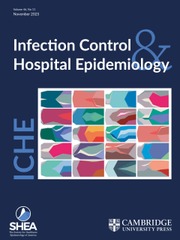Crossref Citations
This article has been cited by the following publications. This list is generated based on data provided by
Crossref.
Vuorisalo, S.
Pokela, R.
and
Syrjälä, H.
1997.
Is single-dose antibiotic prophylaxis sufficient for coronary artery bypass surgery? An analysis of peri- and postoperative serum cefuroxime and vancomycin levels.
Journal of Hospital Infection,
Vol. 37,
Issue. 3,
p.
237.
Vuorisalo, Sailaritta
Pokela, Risto
and
Syrjälä, Hannu
1998.
Comparison of Vancomycin and Cefuroxime for Infection Prophylaxis in Coronary Artery Bypass Surgery.
Infection Control & Hospital Epidemiology,
Vol. 19,
Issue. 4,
p.
234.
Mangram, Alicia J.
Horan, Teresa C.
Pearson, Michele L.
Silver, Leah Christine
and
Jarvis, William R.
1999.
Guideline for Prevention of Surgical Site Infection, 1999.
American Journal of Infection Control,
Vol. 27,
Issue. 2,
p.
97.
Delgado Rodríguez, M.
Martínez Gallego, G.
Gómez Ortega, A.
and
Medina Cuadros, M.
2002.
Quimioprofilaxis en cirugía: problemas y soluciones en su cumplimiento.
Cirugía Española,
Vol. 71,
Issue. 2,
p.
96.
Quenon, J.-L
Eveillard, M
Vivien, A
Bourderont, D
Lepape, A
Lathelize, M
and
Jestin, C
2004.
Evaluation of current practices in surgical antimicrobial prophylaxis in primary total hip prosthesis—a multicentre survey in private and public French hospitals.
Journal of Hospital Infection,
Vol. 56,
Issue. 3,
p.
202.
Edwards, Fred H.
Engelman, Richard M.
Houck, Peter
Shahian, David M.
and
Bridges, Charles R.
2006.
The Society of Thoracic Surgeons Practice Guideline Series: Antibiotic Prophylaxis in Cardiac Surgery, Part I: Duration.
The Annals of Thoracic Surgery,
Vol. 81,
Issue. 1,
p.
397.
Doonquah, Ladi
and
Doonquah, Leleka
2006.
Infection, Host Resistance, and Antimicrobial Management of the Surgical Patient.
Oral and Maxillofacial Surgery Clinics of North America,
Vol. 18,
Issue. 2,
p.
173.
Botía Martinez, Francisco
Blanco Zamora, José
López Sánchez, Ana
Pérez Albacete, Mariano
and
Jordana, Manuel Canteras
2007.
Análisis de los factores de riesgo asociados a infección quirúrgica en un servicio de urología.
Revista de Calidad Asistencial,
Vol. 22,
Issue. 2,
p.
89.
Kaczmarzyk, T.
Wichlinski, J.
Stypulkowska, J.
Zaleska, M.
Panas, M.
and
Woron, J.
2007.
Single-dose and multi-dose clindamycin therapy fails to demonstrate efficacy in preventing infectious and inflammatory complications in third molar surgery.
International Journal of Oral and Maxillofacial Surgery,
Vol. 36,
Issue. 5,
p.
417.
Overturf, Gary D.
2008.
Principles and Practice of Pediatric Infectious Disease.
p.
71.
Anderson, Deverick J.
and
Kaye, Keith S.
2009.
Staphylococcal Surgical Site Infections.
Infectious Disease Clinics of North America,
Vol. 23,
Issue. 1,
p.
53.
Anderson, Deverick J.
and
Kaye, Keith S.
2009.
Staphylococci in Human Disease.
p.
346.
Duncan, Robert A.
2010.
Surgical Intensive Care Medicine.
p.
361.
Anderson, Deverick J.
2011.
Surgical Site Infections.
Infectious Disease Clinics of North America,
Vol. 25,
Issue. 1,
p.
135.
Kusne, Shimon
Mooney, Martha
Danziger-Isakov, Lara
Kaan, Annemarie
Lund, Lars H.
Lyster, Haifa
Wieselthaler, Georg
Aslam, Saima
Cagliostro, Barbara
Chen, Jonathan
Combs, Pamela
Cochrane, Adam
Conway, Jennifer
Cowger, Jennifer
Frigerio, Maria
Gellatly, Rochelle
Grossi, Paolo
Gustafsson, Finn
Hannan, Margaret
Lorts, Angela
Martin, Stanley
Pinney, Sean
Silveira, Fernanda P.
Schubert, Stephan
Schueler, Stephan
Strueber, Martin
Uriel, Nir
Wrightson, Neil
Zabner, Rachel
and
Huprikar, Shirish
2017.
An ISHLT consensus document for prevention and management strategies for mechanical circulatory support infection.
The Journal of Heart and Lung Transplantation,
Vol. 36,
Issue. 10,
p.
1137.
Mei, Jenny
Harter, Kristin
Danhaive, Olivier
Seidman, Dominika
and
Vargas, Juan
2017.
Implications of intrapartum azithromycin on neonatal microbiota.
The Lancet Infectious Diseases,
Vol. 17,
Issue. 3,
p.
253.
Kamaruddin, Anita
Harun, Wan Himratul Aznita Wan
Bakri, Marina Mohd
Abidin, Syafiq Asnawi Zainal
Giribabu, Nelli
and
Syed Abdul Rahman, Syarifah Nur
2024.
Phytochemical profile and antimicrobial activity of Jatropha curcas extracts against oral microorganisms.
Heliyon,
Vol. 10,
Issue. 17,
p.
e33422.
Inagaki, Kengo
Schumacher, Kurt R.
Sood, Vikram
and
Tribble, Alison C.
2025.
Perioperative Antibiotic Prophylaxis for Heart Transplantation at Children’s Hospitals in the United States.
Pediatric Infectious Disease Journal,

